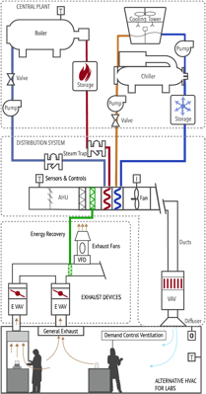Why implement a Smart Labs Program?
Organizations spend hundreds of millions of dollars building laboratories with specialized workspaces that will support scientific activities, attract highly skilled people, inspire innovation, and bolster success of the organization. Laboratory scientific discovery is crucial to the advancement of these institutions, and it is often the main driver of their reputation, growth, and profitability. On the other hand, laboratory buildings are complex, costly, and challenging to operate. People working in labs depend on proper design and operation of the building systems to provide safe and controlled workspaces to support their scientific endeavors. It is critical to get the laboratory airflow control systems right. Many laboratory buildings suffer significant and persistent operational issues that hinder success of lab activities, increase waste, and negatively impact the health of the organization [1], [2], [3]. When left unresolved, these issues can degrade performance, hinder recruitment of top talent, and possibly cause irrevocable harm to people, property, or the environment.
When a Smart Labs program is implemented, an organization has a systems-based management approach that yields a high performing laboratory building. Employing Smart Labs methods during design and construction of new facilities or when upgrading existing facilities can provide significant benefits, including:
- Improved safety and health.
- Reduced energy consumption and lower operating costs.
- Reduced degradation, deferred maintenance and property loss.
- Increased retention and recruitment of top talent in researchers and scientists.
Laboratories typically consume 3 to 10 times more energy than similarly sized commercial buildings and as much as 50% of that energy can be wasted by inefficient and poorly operating fume hoods and ventilation systems. When properly implemented, the Smart Labs approach enables facility stakeholders to plan and cost effectively achieve high performance laboratories that mitigate risk, operate reliably, provide greater flexibility and reduce energy costs by as much as 50%.
HVAC Resource Map
The HVAC Resource Map for Labs is an intuitive graphical interface that provides quick access to a broad array of quality information on operations and maintenance best practices as well as energy and water efficiency measures. The resources cover the central plant, distribution systems, and zone systems. The primary audiences for this resource are facility managers, operations staff, and design engineers who are seeking information for typical HVAC systems as well as for the intricacies of lab systems.
Be a Smart Labs Champion!
People willing to buck the status quo and question all the assumptions which have been touted as best practices for not just years, but decades.
– Wendell Brase, Vice Chancellor, University of California, Irvine
Welcome, Smart Labs champion! You are the crux of the Smart Labs program—your passion and fearless courage will drive its success. Join the ranks of champions across the nation who are bucking the status quo, one lab facility at a time, to make new strides in performance.
Starting a Smart Labs program can seem like a daunting task. Fear not! In addition to the many resources available in this Toolkit, we encourage you to:
- Attend trainings, workshops, and conferences such as the International Institute for Sustainable Laboratories (I2SL) Annual Conference and the Better Buildings Summit to learn from and connect with widespread Smart Labs initiatives
- Enlist the help of professional consultants, including industrial hygienists and energy consultants, when needed to assist your institution's Smart Labs efforts
- Connect with other institutions that have similar processes to learn best practices.
Key Responsibilities of a Smart Labs Champion
Lead the charge!
- Assemble a Smart Labs Team.
- Promote, encourage, and facilitate Smart Labs practices throughout the organization by sharing information on procedures, techniques, and best practices.
- Engage key stakeholders, including management and researchers.
Coordinate efforts!
- Drive the development of goals and a strategic plan for the Smart Labs program.
- Coordinate communication between management, facility operations and maintenance personnel, and research staff in lab facilities.
- Delegate tasks to avoid overburdening of involved parties and ensure continued engagement and progress.
Oversee progress!
- Prepare reports for site management highlighting cost savings and progress toward goals.
- Develop funding strategies for implementing lab improvement projects.
- Ensure the implementation of improvements and new equipment meets performance standards and cost savings.
- Develop new solutions to enhance safe, efficient operation in lab facilities.
Recognize accomplishments!
- Implement a site-level rewards and recognition program for achievements.
- Announce Smart Labs successes to employees and the public.
Campus Planning for Zero Energy
Labs are often a part of a campus complex. As campus managers conduct energy inventories, they discover that laboratory buildings are typically the largest segment of campus energy and carbon impact. Though laboratory facilities may seem to present a challenge to achieving net zero targets, lab spaces are a growing opportunity for testing energy efficient technologies as the payback can be significant. Instead of focusing on building components, the Smart Labs approach uses a whole-building level with a campus-wide perspective to tackle laboratory facility energy consumption.
As a Smart Labs Champion, consider including campus planning to achieve net zero status in early stages of the Smart Labs program. The campus will not be converted overnight. However, keeping the long-term goal for a net zero campus in mind throughout the Smart Labs process will drive key decisions that will help your campus achieve it sooner.
Footnotes
- Smith, T.C. "The Unintended Practice of Using Employee Health as an Indicator of Proper Hood Performance", Journal of Chemical Health and Safety, January/February, 2004. ↵
- Matthew, P. et. Al. "Major energy efficiency opportunities in laboratories—implications for health and safety." Journal of Chemical Health and Safety. 2007. ↵
- Kaplowitz, M. et. Al. "Energy conservation attitudes, knowledge, and behaviors in science laboratories." Energy Policy.Vol. 50, November 2012. ↵
